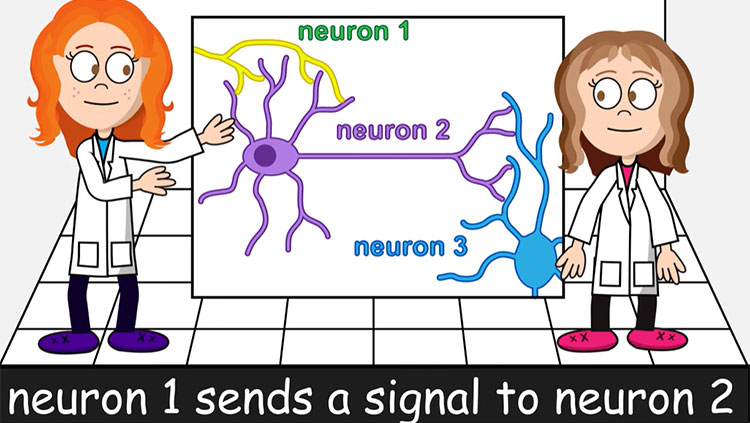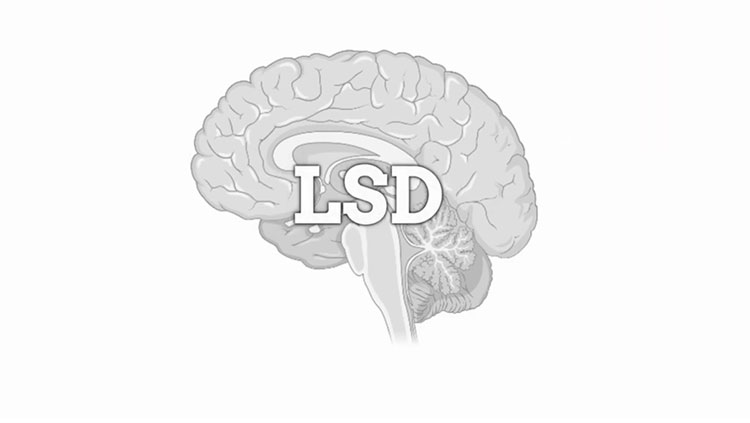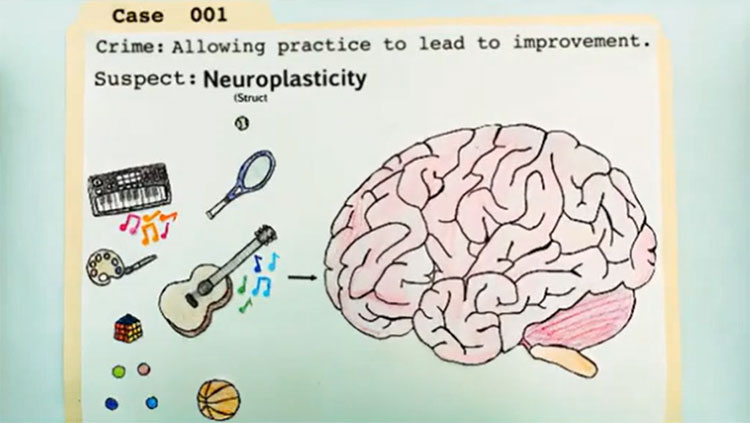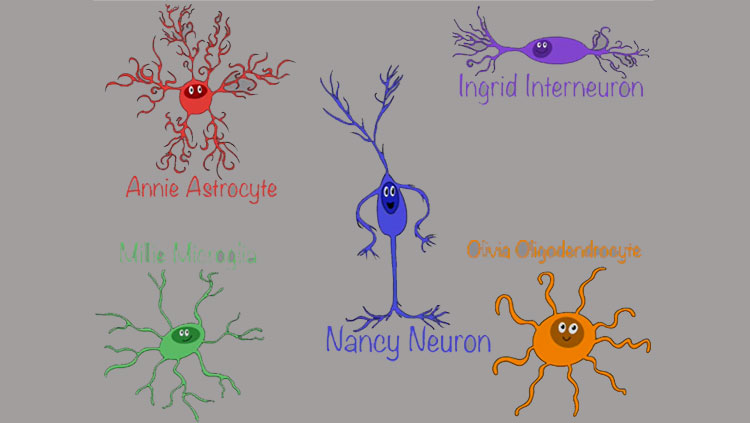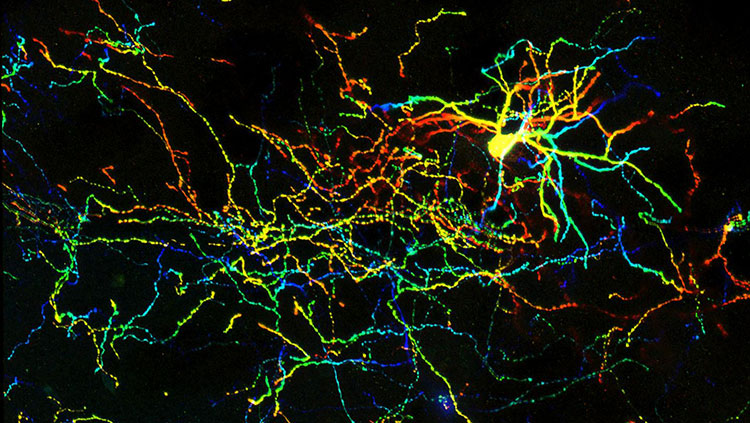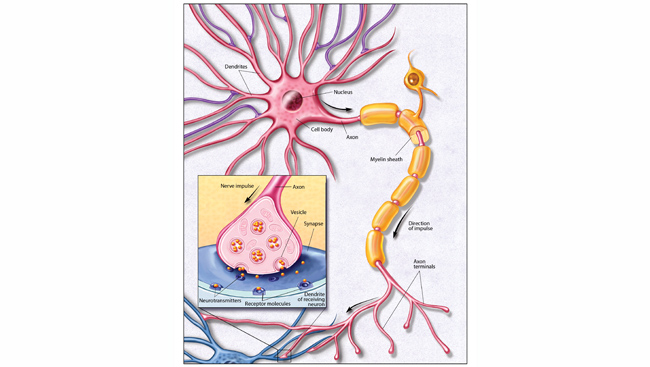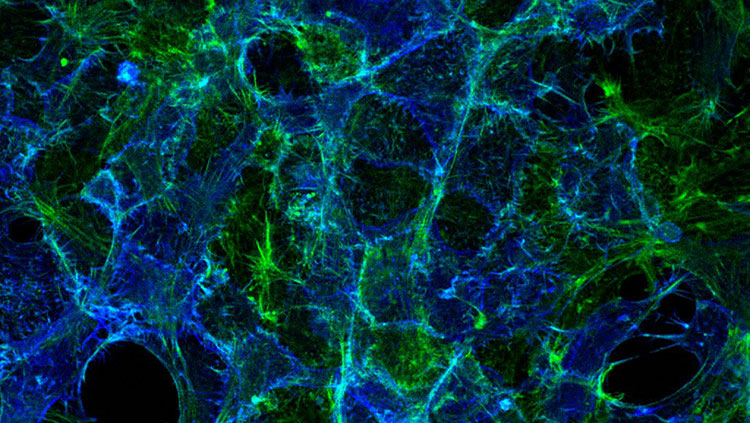Classical Neurotransmitters: Brain Communicators
- Published1 Apr 2012
- Reviewed1 Apr 2012
- Source BrainFacts/SfN
The brain uses a variety of chemicals called neurotransmitters to communicate between brain cells.
Acetylcholine
The first neurotransmitter to be identified — about 80 years ago — was acetylcholine (ACh).This chemical is released by neurons connected to voluntary muscles, causing them to contract, and by neurons that control the heartbeat. ACh is also a transmitter in many regions of the brain.
ACh is synthesized in axon terminals. When an action potential arrives at the nerve terminal, electrically charged calcium ions rush in, and ACh is released into the synapse, where it attaches to ACh receptors on the target cells. On voluntary muscles, this action opens sodium channels and causes muscles to contract. ACh is then broken down by the enzyme acetylcholinesterase and resynthesized in the nerve terminal. Antibodies that block one type of ACh receptor cause myasthenia gravis, a disease characterized by fatigue and muscle weakness.
Much less is known about ACh in the brain. Recent discoveries suggest that it may be critical for normal attention, memory, and sleep. Because ACh-releasing neurons die in Alzheimer’s patients, finding ways to restore this neurotransmitter is a goal of current research. Drugs that inhibit acetylcholinesterase — and increase ACh in the brain — are presently the main drugs used to treat Alzheimer’s disease.
Amino Acids
Certain amino acids can also serve as neurotransmitters in the brain. The neurotransmitters glycine and gamma-aminobutyric acid (GABA) inhibit the firing of neurons. The activity of GABA is increased by benzodiazepines (e.g., Valium) and by anticonvulsant drugs. In Huntington’s disease, a hereditary disorder that begins during midlife, the GABA-producing neurons in brain centers that coordinate movement degenerate, causing uncontrollable movements. Glutamate and aspartate act as excitatory signals, activating, among others, N-methyl-d-aspartate (NMDA) receptors which, in developing animals, have been implicated in activities ranging from learning and memory to development and specification of nerve contacts. The stimulation of NMDA receptors may promote beneficial changes in the brain, whereas overstimulation can cause nerve cell damage or cell death. This is what happens as a result of trauma and during a stroke. Developing drugs that block or stimulate activity at NMDA receptors holds promise for improving brain function and treating neurological and psychiatric disorders.
Catecholamines
The term catecholamines includes the neurotransmitters dopamine and norepinephrine. Dopamine and norepinephrine are widely present in the brain and peripheral nervous system. Dopamine is present in three principal circuits in the brain. The dopamine circuit that regulates movement has been directly linked to disease. Due to dopamine deficits in the brain, people with Parkinson’s disease show such symptoms as muscle tremors, rigidity, and difficulty in moving. Administration of levodopa, a substance from which dopamine is synthesized, is an effective treatment for Parkinson’s, allowing patients to walk and perform skilled movements more successfully.
Another dopamine circuit is thought to be important for cognition and emotion; abnormalities in this system have been implicated in schizophrenia. Because drugs that block certain dopamine receptors in the brain are helpful in diminishing psychotic symptoms, learning more about dopamine is important to understanding mental illness. In a third circuit, dopamine regulates the endocrine system. Dopamine directs the hypothalamus to manufacture hormones and hold them in the pituitary gland for release into the bloodstream or to trigger the release of hormones held within cells in the pituitary.
Deficiencies in norepinephrine occur in patients with Alzheimer’s disease, Parkinson’s disease, and Korsakoff’s syndrome, a cognitive disorder associated with chronic alcoholism. These conditions all lead to memory loss and a decline in cognitive functioning. Thus, researchers believe that norepinephrine may play a role in both learning and memory. Norepinephrine is also secreted by the sympathetic nervous system throughout the body to regulate heart rate and blood pressure. Acute stress increases release of norepinephrine from sympathetic nerves and the adrenal medulla, the innermost part of the adrenal gland.
Serotonin
This neurotransmitter is present in the brain and other tissues, particularly blood platelets and the lining of the digestive tract. In the brain, serotonin has been identified as an important factor in sleep quality, mood, depression, and anxiety. Because serotonin controls different switches affecting various emotional states, scientists believe these switches can be manipulated by analogs, chemicals with molecular structures similar to that of serotonin. Drugs that alter serotonin’s action, such as fluoxetine, relieve symptoms of depression and obsessive-compulsive disorder.
CONTENT PROVIDED BY
BrainFacts/SfN


